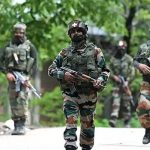Disclaimer: This article details the series of events that unfolded under Operation Sindoor as of May 07, 2025. It does not include Pakistan’s response or the escalation since.
In the early hours of May 07, 2025, the Indian Armed Forces jointly launched Operation Sindoor–a swift, coordinated and high-precision strike across terror launchpads in Pakistan-occupied Jammu and Kashmir (PoJK) and Pakistan. These targets, stretching from Sawai Nala in the north to Bahawalpur in the south, were key training and operational hubs for Lashkar-e-Taiba (LeT), Jaish-e-Mohammed (JeM) and Hizbul Mujahideen (HM). Reportedly, over 80 terrorists from these groups have been killed in this operation, though the official figures are still awaited. The operation was not just military retaliation–it was a calibrated response to one of the deadliest terror attacks on Indian soil in recent years. On April 22, in Pahalgam, 26 Hindu men were brutally killed in cold blood, and the attack claimed the highest civilian casualties since the 26/11 Mumbai attack. India’s patience, tested beyond reason, had run out.
Addressing the press hours after the strikes, Foreign Secretary Vikram Misri did not mince words. He said that the manner of the attack was deliberately designed to provoke communal unrest, not just in Jammu & Kashmir but across the country. Misri confirmed that TRF, a known proxy of Pakistani terror networks and the group responsible for the attack, were in direct communication with handlers across the border in Pakistan. He further noted that India had flagged concerns about the TRF’s activities at the UN’s 1267 Sanctions Committee as early as 2023 and again in 2024. Interestingly, Pakistan attempted to remove TRF’s name from the UN’s condemnation statement for Pahalgam issued on April 25–a move that did not go unnoticed and raised questions about Islamabad’s intent. Misri also called out Pakistan’s duplicitous track record of shielding terrorists while mouthing platitudes of peace to the global community. He cited the case of Sajid Mir at the Financial Action Task Force (FATF)–where a globally wanted terrorist was declared ‘dead’ only to be conveniently ‘found alive and arrested’ under international pressure–as a damning symbol of Pakistan’s credibility crisis.
On Operation Sindoor, the Foreign Secretary condemned Pakistan’s lack of demonstrable action to dismantle the terror infrastructure within its borders or the territory it controls, despite a fortnight having passed since the attack. Instead, Islamabad has only indulged in denials, deflections, and propaganda. It became pertinent for the orchestrators of the attack to be brought to justice. Additionally, intelligence in the days following the Pahalgam attack indicated ongoing preparations for further strikes on Indian soil. So, the need to act–both to deter and pre-empt–became unavoidable.
Unpacking Operation Sindoor
Colonel Sofiya Qureshi of the Indian Army and Wing Commander Vyomika Singh of the Indian Air Force jointly briefed the nation and the world on the operational details of the strikes and released visuals from Op Sindoor. Of 21 known terror camps operating in PoJK and Pakistan, nine were selected based on actionable intelligence (Table 1). In a span of 25 minutes, from 01:05 to 01:30 AM, the sites were completely obliterated with precision capability and deliberate care to avoid civilian casualties. No Pakistani military establishments were targeted. These camps were used by terror outfits for initial and advanced training, indoctrination, recruitment, and operational launching.
| TABLE 1: TERROR CAMPS TARGETED IN OP SINDOOR | ||||
| Camp Name | Location | Distance from Border | Affiliated Group | Details & Activities |
| Camps within PoJK | ||||
| Sawai Nala | Muzaffarabad | 30 km from LoC | Lashkar-e-Taiba | Base for 20 October 2024 Sonmarg, 24 October 2024 Gulmarg, and 22 April 2025 Pahalgam attacks. |
| Syedna Bilal | Muzaffarabad | – | Jaish-e-Mohammed | Staging area. Training in weapons, explosives, and jungle survival. |
| Gulpur | Kotli | 30 km from LoC | Lashkar-e-Taiba | Trained terrorists involved in 30 April 2023 Poonch and 09 June 2024 religious pilgrim attacks. |
| Barnala | Bhimber | 09 km from LoC | – | Training in weapons, IEDs, and jungle survival. |
| Abbas | Kotli | 13 km from LoC | Lashkar-e-Taiba | Fidayeen training camp. Capacity for 15 terrorists. |
| Camps in Pakistan | ||||
| Sarjal | Sialkot | 6 km from International Border (IB) | – | Trained attackers responsible for killing 4 J&K Police personnel in March 2025. |
| Mehmoona Joya | Sialkot | 12-18 km from IB | Hizbul Mujahideen | Large camp. Linked to Kathua terrorism and Pathankot Air Force base attack planning. |
| Markaz Taiba | Muridke | 18–25 km from IB | Lashkar-e-Taiba | Training site for 26/11 Mumbai attackers. Trained Ajmal Kasab and David Headley. |
| Markaz Subhan Allah | Bahawalpur | 100 km from IB | Jaish-e-Mohammed | JeM HQ. Major site for recruitment, training, indoctrination. Regularly visited by top terrorists. |
India deployed a mix of cutting-edge aerial and ground-based weapon systems during Op Sindoor. The Indian Air Force’s (IAF) Rafale fighters, equipped with SCALP (Storm Shadow) missiles, were assigned the most fortified targets deep inside Pakistan’s territory. With a strike range of over 250 kilometres, these air-launched cruise missiles were designed for deep-penetration operations, capable of neutralising high-value assets without crossing the LoC. Simultaneously, Mirage 2000 aircraft deployed Spice-2000 precision-guided bombs–munitions with electro-optical guidance systems and satellite navigation, renowned for their effectiveness in the 2019 Balakot strikes. Providing defensive cover throughout the operation were Su-30 MKI jets, which patrolled the skies to deter potential threats from Pakistani interceptors and ensure the safe execution of the strike package. In addition to SCALP and Spice-2000 munitions, the IAF also employed HAMMER (Highly Agile Modular Munition Extended Range) bombs. Of French origin, these smart bombs were used to strike hardened infrastructure like bunkered or multi-storey training camps run by LeT and JeM. With an effective range of 50-70 kilometres, the HAMMER bombs were instrumental in demolishing structures reinforced to withstand conventional attacks.
Parallel to the aerial offensive, the Indian Army engaged seven of the nine identified camps using high-calibre artillery and loitering munitions, popularly referred to as “kamikaze drones.” These drone systems performed dual roles–conducting real-time surveillance and executing precision strikes. Hovering silently above the targets, they locked on and destroyed terrorist infrastructure with minimal collateral damage. Together, these precision platforms demonstrated India’s enhanced capacity to undertake coordinated, multi-domain strikes against cross-border terror infrastructure, executed decisively without breaching the LoC.
Diplomacy in Action: India’s Outreach Post-Op Sindoor
Even as precision strikes unfolded on the ground, India’s diplomatic machinery was in full swing–measured, proactive, and strategically synchronised. Prime Minister Narendra Modi cancelled his scheduled visits to Croatia, Norway, and the Netherlands, signalling the seriousness with which the Indian government was addressing both the domestic and international dimensions of the post-Pahalgam response. Shortly after the operation, Foreign Secretary Vikram Misri convened a high-level briefing at South Block, New Delhi, for envoys of the UNSC. Notably, the Pakistani envoy was excluded, while China’s Ambassador to India, Xu Feihong, was present. Mr. Misri clarified that India’s strikes were not an act of escalation but a measured response to the terror attack in Pahalgam. He assured diplomats that the operation had achieved its objectives across all nine targeted sites. Responding to queries–including one from U.K. High Commissioner Lindy Cameron about visible damage to mosque structures–Misri stressed that the targets were terror camps operating within larger complexes and not civilian structures. To questions about potential damage to Indian infrastructure, Mr. Misri noted that it was “too early to tell,” while reaffirming India’s commitment to responsible conduct. This diplomatic engagement is part of a broader strategy to pre-empt moves by UNSC member Pakistan and to counter efforts by its allies, particularly China, from initiating discussions or issuing statements unfavourable to India. It also marks a renewed push to hold TRF and other Pakistan-based groups accountable at global platforms like the UN 1267 Sanctions Committee and the FATF.
In parallel, National Security Adviser Ajit Doval held conversations with his counterparts across the world, including the USA, UK, Saudi Arabia, UAE and Japan, briefing them on the scope and intent of India’s operations. He emphasised that India had no desire to escalate tensions but remained fully prepared to respond if provoked. In the immediate aftermath of the operation, Doval also reached out to Russian NSA Sergei Shoigu, Chinese Foreign Minister Wang Yi, and Emmanuel Bonne, Diplomatic Adviser to the French President, to reinforce the transparency and restraint that had guided India’s approach. Meanwhile, External Affairs Minister Dr. S. Jaishankar initiated a fresh round of outreach to key foreign counterparts, including high-level conversations with Qatar, Saudi Arabia, Spain, France, Germany, Japan and maintained scheduled engagements with Iran, whose leadership will arrive in New Delhi on May 08.
At Home: Security Measures and Civil Preparedness
At home, Prime Minister Modi chaired a special Cabinet meeting following Operation Sindoor, during which he commended the armed forces for their swift and precise execution. Cabinet members unanimously welcomed the operation with applause, calling it a moment of national pride and strategic maturity. In response to heightened security concerns, a red alert was issued in Uttar Pradesh, with state police instructed to coordinate closely with Defence units and secure critical infrastructure. In the border states, schools were shut down as a precautionary measure, including in Punjab’s Fazilka, Amritsar, Gurdaspur, Pathankot, and Ferozepur, as well as Rajasthan’s border districts of Ganganagar, Bikaner, Jaisalmer, and Barmer.
A sweeping airspace lockdown followed. Twenty-seven airports across northern, western, and central India suspended commercial operations until 5:29 AM on May 10, resulting in significant disruption. Indian carriers cancelled 430 flights, roughly 3% of all scheduled services, while Pakistan-based airlines cancelled over 147 flights, amounting to 17% of their daily operations. Global flight tracking platforms showed that the airspace over Pakistan and the western Indian corridor–from Kashmir to Gujarat–was nearly devoid of civilian aircraft. India also observed a nationwide civil defence preparedness drive on May 07, involving 244 districts. The drills included air raid sirens, coordinated blackouts, and mock response exercises conducted with the participation of civil defence volunteers, the National Service Scheme (NSS), the National Cadet Corps (NCC), and various grassroots organisations. Prominent national buildings, such as Rashtrapati Bhavan, the Golden Temple, and IGI Airport, took part in the blackout drill. Symbolically, patriotic songs echoed across Lutyens’ Delhi, contributing to a charged national atmosphere of vigilance and solidarity.
Interestingly, ahead of Operation Sindoor, the Airports Authority of India had issued a NOTAM (Notice to Airmen) covering the period between 3:30 PM on May 07 and 9:30 PM on May 08. The IAF clarified that this aligned with a pre-planned two-day training exercise over Rajasthan and other western regions near the international border, coinciding with the nationwide civil defence drills. Together, these internal measures reflect a country that, while executing external strategic objectives, also turned inward to ensure maximum civilian preparedness, infrastructure security, and crisis response coordination.
Conclusion
Operation Sindoor is more than just a strategic military manoeuvre, it is a watershed moment in India’s evolving counterterrorism doctrine. By striking deep into the heart of terror infrastructure with precision and moral clarity, India has not only demonstrated its operational capabilities but also reasserted its will to defend its citizens without hesitation and that India will no longer tolerate proxy terrorism or prolonged inaction from across the border. The nation’s political and military leadership have presented a united front, reaffirming their commitment to safeguarding national security and civilian lives. While the road ahead remains fraught with diplomatic and security challenges, Operation Sindoor has already reshaped the regional security calculus. In the aftermath of the horrific Pahalgam massacre, Operation Sindoor stands as a moment of reckoning. The selection of targets was not only a direct response to the recent killings but also a calculated strike against those responsible for earlier acts of terror. This sends two unequivocal messages: first, that India does not forget; and second, that Pakistan’s long-standing complicity in sheltering, funding, and training terrorists, despite mounting international pressure, remains unchanged. In doing so, it has underscored a broader reality–that India’s red lines are no longer open to interpretation.
The name itself–Operation Sindoor–has moved many across the nation. Traditionally associated with the marital bond between husband and wife, sindoor becomes a symbol of the irreversible loss borne by women who lost their spouses in the Pahalgam attack. These were not just men who died; they were husbands, sons, and brothers–pillars of families now broken. In invoking sindoor, the operation also becomes an honouring of their memory and a tribute to the resilience of the women left behind. It is being read as a gesture of national solidarity with them, acknowledging their grief and embedding it into the moral fibre of India’s response.
Even as India remains alert to further escalation, Operation Sindoor has already reshaped the discourse–militarily, diplomatically, and emotionally. It signals to the world that India’s threshold for terror has been irrevocably crossed, and its answers will be both measured and uncompromising. The message is clear: those who seek to sow fear will face consequences, and those who have suffered shall not be forgotten.












